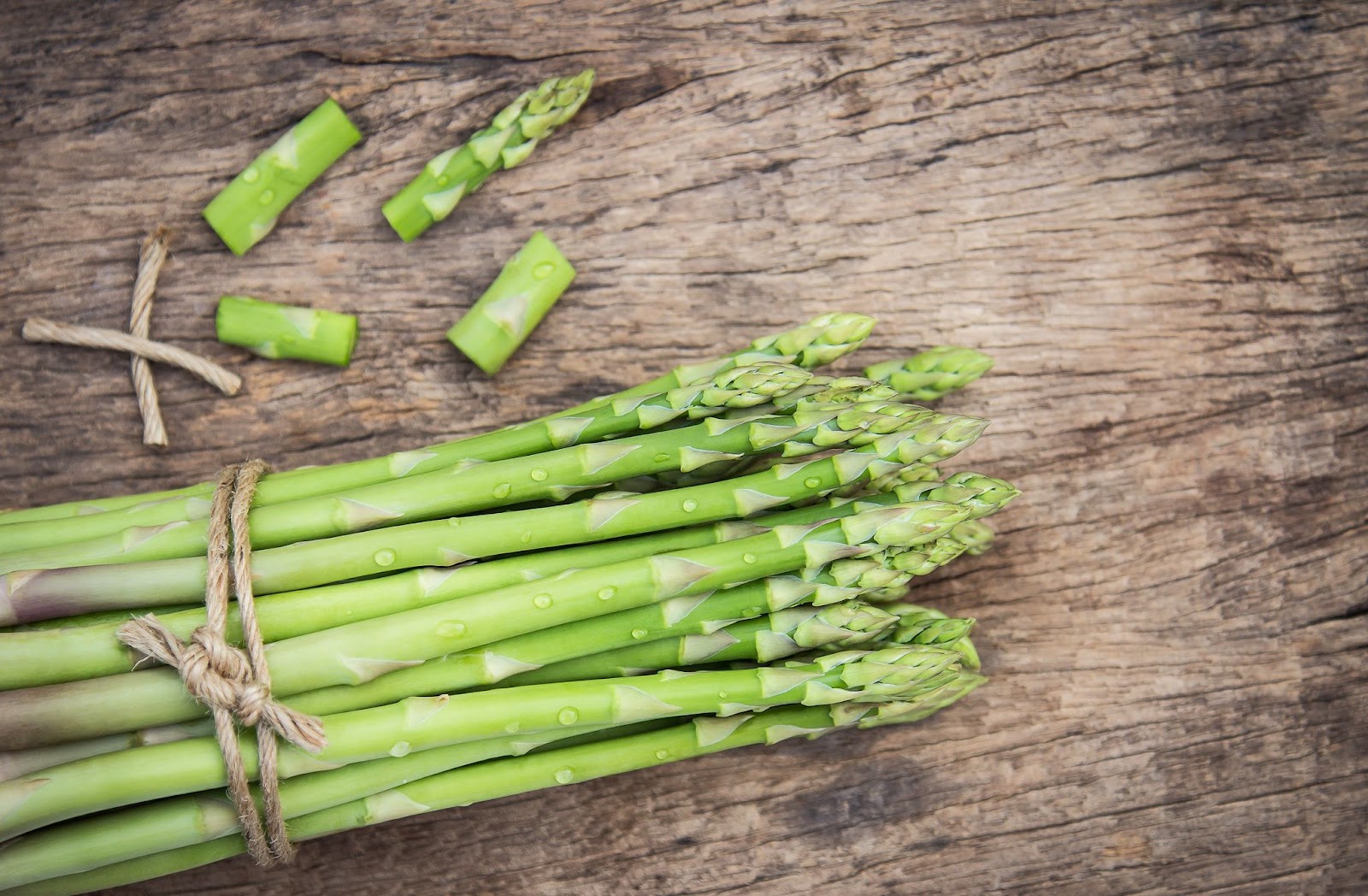To reap the benefits of growing asparagus, consider its high nutritive value, low calorie content, and antioxidant-rich makeup. In addition, asparagus is a good source of dietary fiber. These advantages make it a smart choice for those looking to maximize the nutritional content of their diet.
High Nutritive Value of Asparagus
Asparagus, known for its elevated nutrition content, is a prime vegetable to add to your diet. It packs a significant amount of nutrients like vitamins K, A, and C, folate, minerals such as iron and potassium and high in dietary fiber. These nutrients work together to boost immunity levels, promote healthy brain function, aid digestion, and improve skin health.
In addition to its high nutrient content, asparagus is also low in calories making it an ideal vegetable for people watching their weight. Regular consumption of asparagus may improve overall heart health due to its anti-inflammatory properties and the presence of antioxidants like flavonoids.
Adding asparagus into your meals can be easy – it can be baked or roasted in the oven or even grilled on the BBQ for a tasty side dish or main course accompaniment.
One woman shared her experience of consuming asparagus juice daily over three months – her joint pain reduced dramatically, she felt energized every day with the restoration of her vitality and stamina. As our bodies respond differently to various types of foods, nonetheless including asparagus in your diet could have significant health benefits you will appreciate over time.
Eating asparagus is like a guilt-free trip to flavor town – with only 20 calories per serving, it’s a win for taste buds and waistlines alike.
Asparagus is a Low-Calorie Vegetable
Asparagus is a vegetable that is low in calories and carries many nutritional benefits. The plant has been known to help regulate blood sugar levels and maintain healthy digestion. Further, it’s also believed to promote weight loss due to its detoxifying properties. Asparagus also packs a high dose of Vitamins K, C and E, which are essential for healthy bones and cell generation. Last but not least, the vegetable also contains antioxidants that can help protect the body from chronic diseases.
Here are some of the top benefits of Asparagus:
- Low in Calories
- Helps Regulate Blood Sugar Levels
- Aids Digestion
- Promotes Weight Loss
- Contains High Doses of Essential Vitamins & Antioxidants
Aside from being low in calories and carrying numerous health benefits, asparagus has an additional benefit when it comes to preparation. It can be enjoyed raw or cooked in a variety of recipes, making it versatile for many different occasions.
The history of asparagus goes back to ancient times, where it was used for medicinal purposes by ancient Greeks as a natural diuretic and a cure for toothaches. It wasn’t until the 15th century that asparagus was introduced into English cuisine. Since then, it’s become a staple ingredient around the world in various cultural dishes such as stir fries, salads and soups.
With all those antioxidants, eating asparagus is like fighting off free radicals with tiny green spears.
Asparagus is Packed with Antioxidants
Asparagus brims with copious amounts of antioxidants that help in the proper functioning of our body. Antioxidants fight against free radicals and reduce the risk of chronic diseases like cancer, diabetes, and heart diseases. Additionally, they improve brain function and boost immunity making our body stronger to fight off illnesses.
Moreover, asparagus is rich in folate which contributes to healthy development during pregnancy and supports heart health. The presence of fiber also aids in digestion while Vitamin K helps in the clotting of blood.
To make the most of these health benefits, it is recommended to consume asparagus by steaming or roasting them as these methods preserve more nutrients. Incorporating them into a balanced diet along with other nutrient-dense foods like fruits, legumes can lead to overall better health.
Looks like eating asparagus isn’t just good for your digestive health, it’s also a great way to ensure your farts aren’t just silent, but deadly.
Asparagus is a Good Source of Dietary Fiber
Asparagus is a valuable vegetable that provides several health benefits, including being an excellent source of dietary fiber. This high fiber content can aid in digestion and promote bowel regularity. Additionally, asparagus contains prebiotics that stimulate the growth of healthy gut bacteria, further improving digestive health.
Incorporating asparagus into your regular diet plan can be an easy and effective way to increase your fiber intake. Including other high-fiber foods like fruits, vegetables, and whole grains can also improve overall digestive health. Consistently drinking enough water is also crucial for optimal digestive function and supporting the body’s ability to absorb nutrients from food.
Apart from aiding in digestion, consuming asparagus can offer numerous other health benefits due to its nutrient profile. This superfood is a rich source of vitamins A, C, E, K, and B6 as well as minerals like iron and potassium. These nutrients play vital roles in supporting various bodily processes such as immune system function and blood cell production.
Overall, incorporating this nutritious vegetable into your diet plan can provide you with numerous health benefits due to its high fiber content and rich nutrient profile.
Growing asparagus from cuttings is like creating a mini army of delicious green soldiers, ready to invade your taste buds.
How to Grow Asparagus from Cuttings
To grow asparagus from cuttings, you need to know the proper techniques for selecting, preparing, planting, and caring for the plants. In this section, we will guide you through the process of growing asparagus from cuttings with step-by-step instructions. The sub-sections cover everything from selecting the right cuttings for propagation to caring for the newly planted asparagus cuttings.
Selecting the Right Cuttings for Propagation
Selecting Suitable Cuttings for Asparagus Propagation
To grow asparagus from cuttings, it’s crucial to select suitable cuttings to ensure successful propagation.
- Choose healthy-looking plants with well-developed shoots and roots.
- Make sure the cuttings are free from pest infestations or disease.
- Select a cutting that is at least 6 inches long, with intact nascent roots and several buds.
- Avoid taking cuttings from female plants as they produce seeds that have a meager germination rate.
- Cut only during the dormant season (fall to early spring).
- Be patient and gentle when handling the cuttings not to damage them.
Selecting appropriate cuttings is essential for thriving asparagus growth. Making selections that meet these criteria will help achieve optimal results.
Pro Tip: Always select more cuttings than needed, as some may not develop into viable asparagus plants.
Get ready to give your garden a little aspara-gus.
Preparing the Cuttings for Planting
To foster successful growth of asparagus plants from cuttings, a systematic approach to the preparation of the asparagus cutting must be taken. This involves taking into account various factors such as the soil quality, water supply, and climate conditions. Here are the steps to prepare an asparagus cutting for planting:
- Obtain healthy asparagus cuttings from a mature plant
- Cut the selected cutting to a length of 6-8 inches using a sterilized knife or scissors
- Remove any leaves or side branches from the bottom half of the cutting
- Dust powdered rooting hormone on the cut end of the stem, tapping off any excess to avoid soaking
- Once done, gently insert the cutting into moistened potting soil in a well-draining container
Following these steps will ensure that your asparagus cuttings are ready and set up for optimal growth.
It’s important to note that while preparing your cuttings for planting, one must also rotate the location where you plant them as this promotes diverse development throughout your garden bed.
Legend has it that in ancient times, Asparagus was held in high esteem and was believed to have aphrodisiac properties which many cultures claimed would improve fertility when consumed in large quantities.
Get ready to dig deep and get dirty, because preparing the soil for planting asparagus is no bed of roses.
Preparing the Soil for Planting
To prepare the soil for planting asparagus cuttings, proper ground preparation is necessary. The soil must be fertile, well-draining, and have a pH level of 6.5 to 7.5.
The following six steps will guide you on how to prepare the soil for planting asparagus cuttings effectively:
- Start by selecting a location that receives full sunlight and has good drainage.
- Remove all rocks, debris, and weeds from the area.
- Add compost or aged manure to the soil to enrich it with nutrients.
- Till the soil to a depth of at least 8 – 10 inches to loosen it and improve air circulation in the ground.
- Level the soil surface using a rake or hoe and ensure there are no bumps or depressions on it.
- Sprinkle lime on top of the soil if its pH level is below 6.5 to raise its alkalinity.
Remember that asparagus can survive in poor soils; however, their growth and yield will not be optimal if grown in such environments.
For best results when preparing the soil for planting asparagus cuttings, consider testing your soil before making any amendments. This way, you’ll know precisely which nutrients your soil lacks and how to fix it.
Asparagus may take years to fully mature, but at least you have something to look forward to besides the inevitable march towards your own decrepit mortality.
Planting the Asparagus Cuttings
To establish your asparagus crop, you need to know how to propagate it from cuttings. Ensure a successful harvest with our guide on Planting Asparagus Cuttings.
- Prepare the soil by digging over and adding manure.
- Dig trenches 6 inches deep and space them about 18 inches apart.
- Create a hump along each trench’s centerline so that the top of each hump is 3 inches above the trench bottom.
- Place the asparagus cuttings on each hump, with at least two buds underground in an upright position.
- Cover with soil, and flatten down lightly with your hands to prevent air pockets.
- Water well, keep moist, and wait for about three weeks for sprouts to emerge.
For healthy growth, ensure consistent watering and remove any emerging weed regularly.
Do not assume that cuttings will establish and thrive automatically; follow the steps outlined to jump-start a successful crop of asparagus.
Remember, caring for asparagus cuttings is a lot like raising children – give them plenty of love, attention, and water, and they’ll grow up to be tall, strong, and delicious.
Caring for the Newly Planted Asparagus Cuttings
Newly planted asparagus cuttings demand proper care for healthy growth and optimal harvest. To ensure that your asparagus cuttings thrive, follow these simple steps:
- Water your asparagus cuttings regularly to keep the soil moist but not waterlogged.
- Provide enough sunlight by placing the container in a sunny spot and keeping it away from shade.
- Fertilize the newly planted asparagus cuttings by using an all-purpose fertilizer with balanced nutrients every two weeks to promote growth.
It is important to note that overwatering should be avoided, so monitor the moisture levels and adjust water application accordingly.
Adequate care of your newly planted asparagus cutting involves regular watering, sufficient sunlight exposure, and timely fertilization. With proper attention, you should expect excellent yields from a healthy harvest.
Pro Tip: Protect your Asparagus plants from weeds by mulching around the crown of each plant.
Harvesting asparagus is like playing hide-and-seek with terrestrial snakes, but the reward is much more delicious.
Harvesting and Maintaining Asparagus
To maximize the yield of your asparagus crop, you need to know how to properly harvest and maintain your plants. In this section, we will provide you with the necessary knowledge to care for your asparagus plants. We will cover topics such as harvesting asparagus, maintaining asparagus plants, and dealing with common asparagus pests and diseases.
Harvesting Asparagus
Asparagus Harvesting:
Harvesting asparagus at the right time ensures that you get a bountiful and healthy yield. Follow these five steps for optimal harvesting of your crop:
- Cut the spears when they are 6-8 inches tall, and before their tips start to open up.
- Use a sharp knife or clippers, and cut them at ground level. Be careful not to damage any emerging spears and take care to avoid disturbing the roots.
- Collect all harvested spears daily, including those that are too thin, deformed or have started to branch out. These will allow your plants more energy to produce better quality shoots next year.
- If some spears have grown too big for consumption, don’t throw them away; let them grow into ferns instead. These ferns will help provide nutrients to the roots and store up food for next year’s crop.
- Make sure you stop harvesting by mid-June in North America, giving ample time for your plants to prepare for winter dormancy. For warmer regions like Florida where winter temperatures don’t drop below -20°F/-28°C, you can harvest till December if there’s no sign of frostbite yet.
Make sure to rotate your harvest locations yearly as well.
Additionally, Asparagus grows best in well-drained soil that is rich in organic matter. It needs plenty of sunlight and phosphorus along with nitrogen. Keep your soil pH level slightly acidic from 6-7.
A True Story:
If you haven’t already eaten fresh Asparagus minutes after it has been harvested from an organic farm yard planted with drip irrigation piping system on moist grounds with early-morning dew during late spring season then you’re missing out on life’s greatest delicacy!
Maintaining asparagus plants is like having a high-maintenance girlfriend: you have to constantly weed out what’s not wanted and give them lots of attention, but in the end, it’s always worth it for the delicious rewards.
Maintaining Asparagus Plants
Asparagus plants require consistent maintenance for optimum growth and productivity. Follow these five easy steps to ensure your asparagus plants stay healthy and productive:
- Keep the soil moist but not waterlogged.
- Fertilize regularly with nitrogen-rich fertilizers for optimal yield.
- Monitor pests and diseases and take appropriate measures to control them.
- Trim the dead foliage in the fall after it turns brown to prevent pests from overwintering.
- Mulch around the plants to retain moisture and control weeds.
It is essential to harvest asparagus frequently, as it can grow several inches in a day during its peak season. Harvest by cutting the spears at or slightly below ground level once they reach about 6-8 inches tall before their tips start branching out.
Proper maintenance eliminates potential problems and prolongs plant life. Always wear gloves when working on your asparagus bed to avoid injuring yourself while trimming.
Looks like those pesky asparagus pests and diseases won’t be getting a taste of my delicious green stalks anytime soon – thanks to my trusty bug spray and pruning shears.
Dealing with Common Asparagus Pests and Diseases
Asparagus plants are susceptible to various pests and diseases, which can significantly reduce their productivity and affect their lifespan. Here are some ways to manage common asparagus-related issues:
- Ensure proper spacing between plants for good air circulation and avoid overcrowding.
- Use organic pesticides or herbicides that protect the plants against pests without harming beneficial insects.
- Remove diseased parts of the plant and dispose of them properly, as this helps prevent the spread of diseases.
It is important to note that asparagus rust is a common disease that affects the crop – it appears on stems in early summer as tiny orange or brown spots. To avoid this, ensure good drainage, avoid over-fertilizing with nitrogen-based fertilizers and remove all debris at the end of each growing season.
Pro Tip: Regular inspection of your asparagus bed will help you identify problems early before they become too severe.
Asparagus: because sometimes you gotta make your pee smell funny to know you’re doing it right.
Cooking with Asparagus
To cook delicious asparagus dishes, you need to prepare it properly. This is where the sub-section ‘How to Prepare Asparagus for Cooking’ will help you. We have also included ‘Popular Asparagus Recipes’ to give you some ideas. Lastly, with ‘Tips for Cooking Asparagus’, you can ensure that your dish is steamed or roasted to perfection.
How to Prepare Asparagus for Cooking
Asparagus is a versatile and nutritious vegetable that can be prepared and cooked in various ways depending on one’s preference. Here’s a quick guide on how to get your asparagus ready for cooking.
- Wash the asparagus under cold running water to remove any dirt or debris.
- Trim off the woody ends of each spear by gently snapping them off or using a knife. The woody part usually starts from the bottom quarter of the spear.
- If you prefer, you can peel off the tougher skin on the lower half of the spears using a vegetable peeler. This step is optional, but it makes the asparagus more tender and easier to cook.
- Cut the asparagus into pieces of desired length – whole spears, 1-inch pieces, or any size in between depending on your recipe.
When selecting asparagus at the grocery store or farmer’s market, look for bright green spears with tightly closed tips and firm stems. Asparagus stays fresh for up to five days if stored properly in a plastic bag with damp paper towels to keep it moist.
Enjoy your freshly prepared asparagus sautéed, roasted, grilled, boiled, steamed or even raw in salads! The possibilities are endless.
Don’t miss out on adding this delicious vegetable to your meals. Follow these simple steps for preparing asparagus and experiment with different cooking techniques to find your favorite way to enjoy it!
Get ready for a kitchen revolution with these popular asparagus recipes – they’ll make you forget all about your previous vegetable obsessions.
Popular Asparagus Recipes
Asparagus is a highly coveted seasonal vegetable that has found its way into many dishes. Here are six scrumptious asparagus recipes you can easily make at home:
- Asparagus and goat cheese tart
- Roasted asparagus with garlic and parmesan
- Lemon, garlic and herb grilled asparagus
- Sautéed asparagus and mushrooms
- Prosciutto-wrapped asparagus spears
- Chicken and asparagus stir-fry
Apart from these popular dishes, there are also lesser-known ways to enjoy the delicate flavor of this versatile vegetable. Whether grilled, roasted, or sautéed, there’s an asparagus recipe out there for everyone.
Did you know that ancient Greeks ate cooked asparagus for its medicinal properties? They believed it was a natural diuretic and could relieve toothaches.
Get tender, flavorful asparagus every time by ditching the microwave and steaming it like your ex’s dreams.
Tips for Cooking Asparagus
The art of preparing asparagus has been perfected over time. Here are some valuable insights into how to cook asparagus like a pro.
- Blanching: To retain the vibrant green color and crisp texture of your asparagus, try blanching it in boiling salted water for a few minutes before cooking.
- Grilling: For a smoky flavor, grill your asparagus until tender. Brush with olive oil and sprinkle with salt and pepper to add more flavor.
- Roasting: If you want to add depth of flavor to your asparagus, try roasting it in the oven with olive oil, salt, and black pepper until caramelized.
- Sautéing: For a quick option, sauté your asparagus with garlic or shallots in butter or oil on high heat for five minutes.
When choosing asparagus at the store, look for bright green stalks that are firm and straight. Asparagus contains vitamins A, C, E, K and is known to be a quick source of fiber.
Growing asparagus from cuttings may seem daunting, but the delicious end result is worth the effort – just like a good workout, or avoiding your ex at a party.













